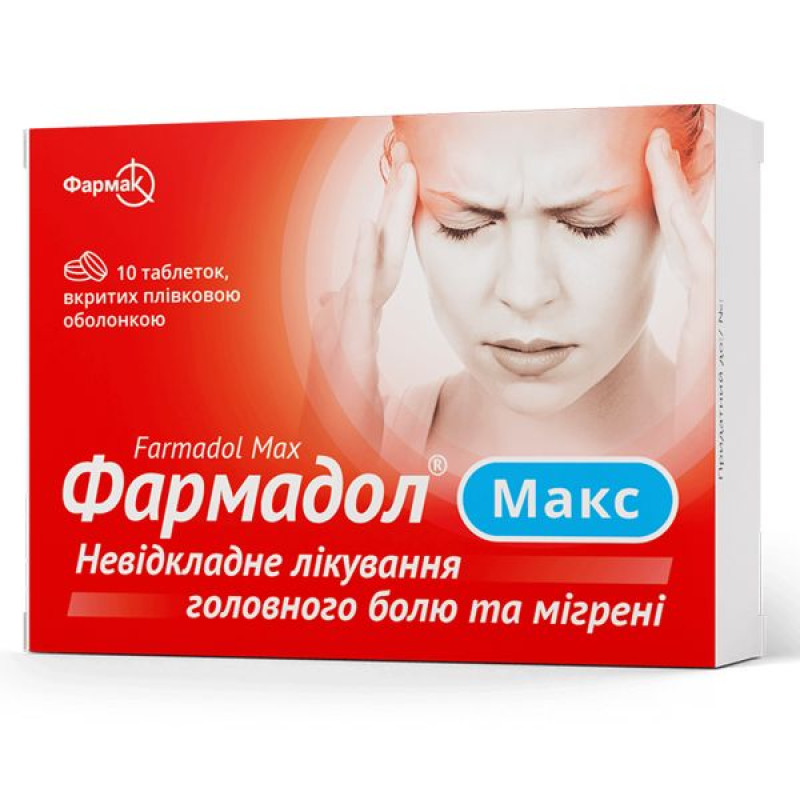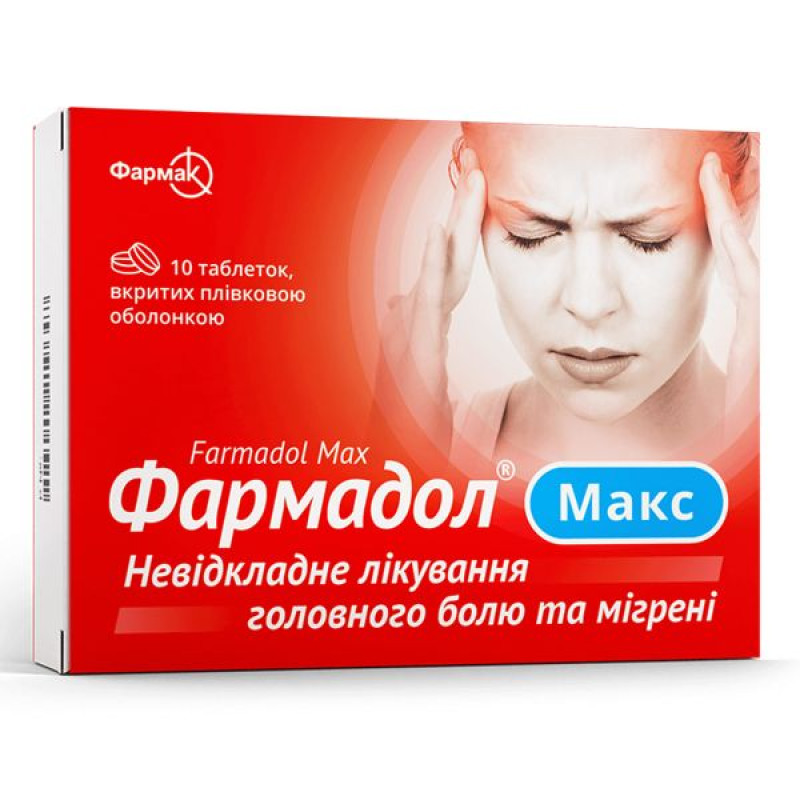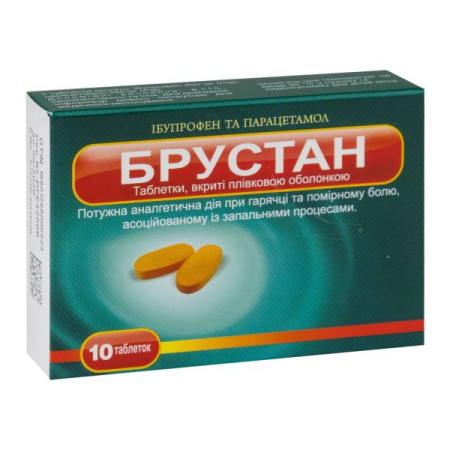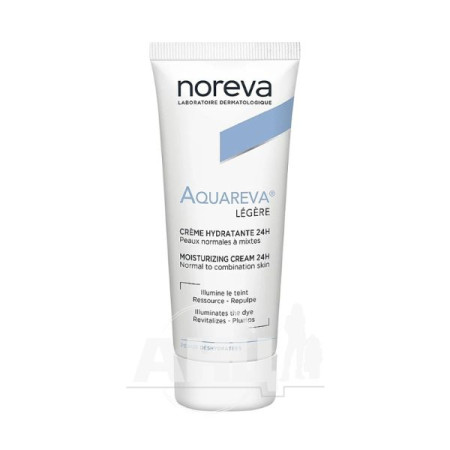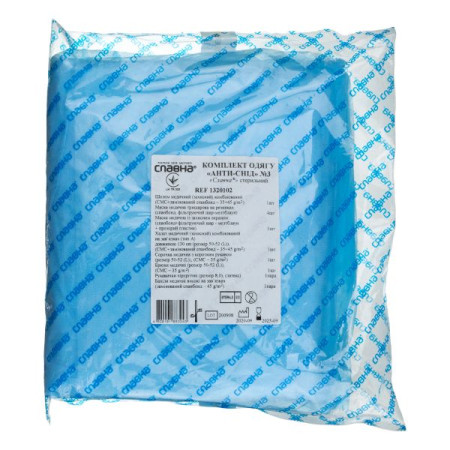Farmadol Max film-coated tablets No. 10
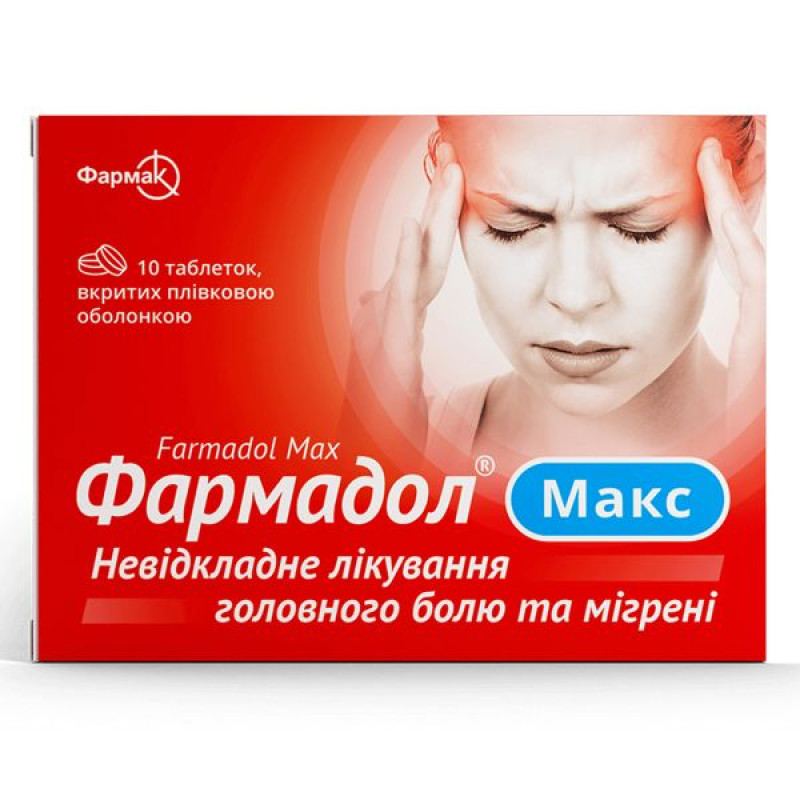
Instructions for use of Pharmadol Max film-coated tablets No. 10
Composition
active ingredients: acetylsalicylic acid, paracetamol, caffeine;
1 film-coated tablet contains: acetylsalicylic acid 250 mg, paracetamol 250 mg, caffeine 65 mg;
excipients: microcrystalline cellulose, low-substituted hydroxypropyl cellulose, stearic acid, hydroxypropyl cellulose;
film coating: hypromellose, titanium dioxide (E 171), macrogol.
Dosage form
Film-coated tablets.
Main physicochemical properties: oblong tablets, with a biconvex surface, film-coated, white or almost white in color.
Pharmacotherapeutic group
Analgesics and antipyretics. Acetylsalicylic acid, combinations without psycholeptics.
ATX code N02B A51.
Pharmacological properties
Pharmacodynamics.
In the combination consisting of paracetamol, acetylsalicylic acid and caffeine, paracetamol acts as an analgesic and antipyretic. Due to the inhibition of prostaglandin synthesis, acetylsalicylic acid (ASA) has an analgesic, antipyretic and anti-inflammatory effect, caffeine provides activation of the analgesic effect of paracetamol and ASA.
Pharmacokinetics.
Acetylsalicylic acid (ASA)
Absorbed rapidly and completely after oral administration. Hydrolyzed in plasma to salicylic acid, which is then metabolized mainly in the liver and excreted together with metabolites by the kidneys.
Paracetamol
Paracetamol is rapidly and almost completely absorbed from the gastrointestinal tract. Binding to plasma proteins is negligible at therapeutic doses. Paracetamol is metabolized in the liver and excreted mainly in the urine as glucuronides and sulfate conjugates. Less than 5% is excreted as unchanged paracetamol.
Caffeine
Caffeine is rapidly and completely absorbed from the gastrointestinal tract, with peak concentrations occurring between 5 and 120 minutes after administration. No data are available on its presystemic metabolism. Caffeine is evenly distributed in all body fluids. The average plasma protein binding is 35%. In adults, it is almost completely metabolized in the liver. The elimination rate in adults varies. The average plasma half-life is 4.9 hours with a range of 1.9–12.2 hours.
Caffeine is almost completely metabolized by oxidation, demethylation and acetylation and is excreted in the urine. Its main metabolites are 1-methylxanthine, 7-methylxanthine, 1,7-dimethylxanthine (paraxanthine). Related metabolites: 1-methyluracilic acid and 5-acetylamino-6-formylamino-3-methyluracil (AMFU).
There is no cross-interaction of the three active ingredients, as well as an increased risk of interaction with other drugs when using the active ingredients in combination. Due to the combination of the three active ingredients, the content of each of them is low, which, accordingly, reduces the toxicity of the drug.
Clinical trial data
Clinical trials have shown the effectiveness of the drug in the treatment of acute migraine attacks, which consists in alleviating migraine symptoms such as headache, nausea, sensitivity to light and sound, and functional disorders. It has been proven that the drug's effect on reducing migraine symptoms begins within 30 minutes.
The drug has also been proven effective in treating headaches. Headache relief was felt by patients 15 minutes and within 4 hours after taking the drug.
Preclinical data
There are no data on studies using modern standards for assessing the toxic effects of paracetamol on fertility and fetal development.
Indication
Emergency treatment of headache and migraine attacks with or without aura.
Contraindication
- Hypersensitivity to the active substances of the drug or to its other components; history of asthma attacks, bronchospasm, angioedema, urticaria or acute rhinitis caused by taking acetylsalicylic acid or other non-steroidal anti-inflammatory drugs (NSAIDs);
- open stomach ulcer or history of stomach ulcer; gastrointestinal bleeding or perforation associated with NSAID therapy;
- hemophilia, hyperbilirubinemia, or other blood clotting disorders;
- renal failure (glomerular filtration rate (GFR) < 15 ml/min/1.72 m2);
- liver failure, history of gout;
- hypersensitivity to other xanthine derivatives (theophylline, theobromine), other salicylates; glucose-6-phosphate dehydrogenase deficiency;
- blood diseases; severe anemia; leukopenia; states of increased excitement; sleep disorders; old age; glaucoma; alcoholism;
- the period of use of monoamine oxidase inhibitors (MAO), as well as the period within 2 weeks after their discontinuation; severe cardiovascular diseases, including rhythm disorders;
- pronounced atherosclerosis;
- severe form of coronary heart disease;
- severe heart failure;
- severe arterial hypertension;
- use of more than 15 mg of methotrexate per week;
- the last trimester of pregnancy.
Interaction with other medicinal products and other types of interactions
The drug should not be used with other NSAIDs, including ASA and specific cyclooxygenase-2 (COX-2) inhibitors, as this increases the risk of adverse reactions.
Possible types of interactions between active substances
Acetylsalicylic acid (ASA)
| Use of acetylsalicylic acid in combination with other drugs | Possible consequence |
Other non-steroidal anti-inflammatory drugs (NSAIDs) | This medicine should not be used with NSAIDs as this increases the risk of adverse reactions. |
| Oral anticoagulants and platelet aggregation inhibitors | ASA may enhance the anticoagulant effect of oral anticoagulants such as heparin and coumarin, and platelet aggregation inhibitors such as ticlopidine, clopidogrel, cilostazol, thus increasing the risk of bleeding. Clinical and laboratory monitoring of bleeding time and prothrombin time is necessary. |
| Thrombolytics | There is an increased risk of bleeding. In particular, in patients with acute stroke, ASA therapy should not be initiated within the first 24 hours after administration of alteplase. Therefore, the use of this combination is not recommended. |
| Uricosuric agents (e.g., probenecid, sulfinpyrazone) | ASA may reduce their activity by inhibiting tubular resorption, leading to high levels of ASA and uric acid in blood plasma. |
| Loop diuretics (e.g., furosemide) | ASA may reduce their activity by competition and inhibition of urinary prostaglandins. NSAIDs may cause acute renal failure, especially in dehydrated patients. When diuretics are used concomitantly with ASA, measures should be taken to ensure adequate hydration of the patient and to monitor renal function and blood pressure, especially at the beginning of diuretic therapy. |
| Phenytoin | While taking ASA, the concentration of phenytoin in the blood plasma increases. It is necessary to carefully monitor the level of phenytoin in the blood plasma. |
| Valproate | ASA inhibits the metabolism of valproate, so its toxicity may increase. It is necessary to carefully monitor the level of valproate in the blood plasma. |
| Methotrexate (≤ 15 mg/week) | Methotrexate toxicity may be increased by concomitant administration of ASA. If combination therapy is necessary, renal function should be monitored. |
| Sulfonylurea derivatives | ASA enhances their hypoglycemic effect, so it may be advisable to slightly reduce the dose of the antidiabetic agent if high doses of salicylates are used. More frequent monitoring of blood glucose levels is recommended. |
| Alcohol | There is an increased risk of gastrointestinal bleeding. |
| Diuretics and antihypertensives (angiotensin-converting enzyme (ACE) inhibitors, angiotensin II receptor antagonists, calcium channel blockers) | ASA may reduce their activity. The use of such a combination requires caution. It is necessary to periodically monitor blood pressure in patients, especially in the elderly, and to ensure adequate hydration of the patient and monitoring of renal function after the start of concomitant therapy and periodically thereafter, especially when using diuretics and ACE inhibitors, due to the risk of nephrotoxicity. In the case of simultaneous use with potassium-sparing drugs, an increase in plasma potassium concentration may be observed, which should be monitored. |
| Antacids | Antacids can increase ASA excretion by alkalinizing the urine. |
| Selective serotonin reuptake inhibitors (SSRIs) | SSRIs when used concomitantly with ASA increase the risk of gastrointestinal bleeding. |
| Corticosteroids | There is an increased risk of gastrointestinal ulcers and bleeding due to synergistic effects. For patients taking ASA and corticosteroids, especially the elderly, it is recommended to consider the appropriateness of prescribing gastroprotectors. Systemic glucocorticosteroids reduce the level of salicylates in the blood and increase the risk of overdose after the end of treatment. Therefore, the use of such a combination is not recommended. |
| Heparin | There is an increased risk of hemorrhagic complications. Clinical and laboratory monitoring of bleeding time is necessary. Therefore, the use of this combination is not recommended. |
| Digoxin | With simultaneous use, the concentration of digoxin in the blood plasma increases due to a decrease in renal excretion. |
| Aldosterone antagonists (spironolactone, canrenoate) | ASA may reduce their activity due to inhibition of urinary sodium excretion. Blood pressure should be carefully monitored. |
Paracetamol
| Use of paracetamol in combination with other drugs | Possible consequence |
| The anticoagulant effect of warfarin and other coumarins with an increased risk of bleeding may be enhanced by long-term regular use of paracetamol. Single use has no significant effect. | |
| Liver enzyme inducers or substances with potential hepatotoxicity (e.g. alcohol, rifampicin, isoniazid, hypnotics and antiepileptics, including phenobarbital, phenytoin and carbamazepine) | Increased toxicity of paracetamol, which may lead to liver damage, even at doses of paracetamol that are not harmful under other circumstances. In this regard, it is necessary to monitor liver function tests. Concomitant use is not recommended. |
| Chloramphenicol | The risk of increased plasma concentrations of chloramphenicol may increase during therapy with paracetamol. Concomitant use is not recommended. |
| Zidovudine | Against the background of paracetamol therapy, the risk of neutropenia may increase, therefore, it is necessary to monitor the indicators of the hematopoietic system. Simultaneous use is not recommended, except in cases where such use is carried out under the supervision of a physician. |
| Probenecid | Probenecid reduces the clearance of paracetamol, therefore, when used simultaneously with this drug, the dose of paracetamol should be reduced. Concomitant use is not recommended. |
| Oral anticoagulants | Anticoagulant effects are enhanced with repeated use of paracetamol for more than 1 week. Irregular use of paracetamol does not significantly affect coagulation. |
| Propantheline or other drugs that slow the evacuation of stomach contents | These medicines slow down the absorption of paracetamol. The analgesic effect may be delayed and less pronounced. |
| Metoclopramide or other drugs that accelerate the evacuation of stomach contents | These active ingredients accelerate the absorption of paracetamol, increasing its effectiveness and accelerating the onset of the analgesic effect. |
| Flucloxacillin | Caution should be exercised when using paracetamol with flucloxacillin, as concomitant administration is associated with metabolic acidosis with an increased anion gap, especially in patients with risk factors (see section "Special warnings and precautions for use"). |
| Cholestyramine | Cholestyramine causes a decrease in the absorption of paracetamol, therefore, if you want to achieve maximum analgesic effect, cholestyramine should be taken no earlier than 1 hour after taking paracetamol. |
Caffeine
| Use of caffeine in combination with medications | Possible consequence |
| Sleeping pills (e.g., benzodiazepines, barbiturates, antihistamines) | When used concomitantly, the hypnotic effect may be reduced or the anticonvulsant effect of barbiturates may be suppressed. Therefore, concomitant use is not recommended. If concomitant use of these drugs is necessary, it may be more beneficial to take the combination in the morning. |
| Lithium preparations | Caffeine may increase the excretion of lithium from the body, therefore simultaneous use of the drug with lithium preparations is not recommended. |
| Disulfiram | Patients with alcohol dependence who are being treated for their dependence with disulfiram should be advised to avoid caffeine to prevent the risk of worsening alcohol withdrawal syndrome due to caffeine-induced cardiovascular and cerebral excitation. |
| Ephedrine-type substances | The use of such a combination may increase the risk of dependence. Therefore, simultaneous use is not recommended. |
| Sympathomimetics or levothyroxine | When using this combination, the tachycardic effect may be more pronounced due to synergistic effects. Therefore, simultaneous use is not recommended. |
| Theophylline | With simultaneous use, the excretion of theophylline may decrease. |
| Quinolone antibacterials (ciprofloxacin, enoxacin, and pipemidic acid), terbinafine, cimetidine, fluvoxamine, and oral contraceptives | Increased half-life of caffeine due to inhibition of the hepatic cytochrome P450 pathway. Therefore, patients with impaired liver function, cardiac arrhythmias, or latent epilepsy should avoid caffeine. |
| Nicotine, phenytoin, and phenylpropanolamine | These substances increase the half-life of caffeine. |
| Clozapine | Caffeine increases serum levels of clozapine, likely due to an interaction mediated by both pharmacokinetic and pharmacodynamic mechanisms. Serum clozapine levels should be monitored. Therefore, concomitant use is not recommended. |
| Analgesics-antipyretics | Increasing their effect |
Impact on laboratory test results
- The use of paracetamol may affect the results of uric acid determinations using the phosphotungstic acid reagent method and the results of glycemia determinations using the glucose oxidase/peroxidase method.
- Caffeine may antagonize the effect of dipyridamole on myocardial blood flow and thus affect the results of this test. It is recommended that caffeine be discontinued 8–12 hours before this test.
Application features
- Keep the medicine out of the reach and sight of children.
- Use with caution in patients with suspected migraine, who have not previously been diagnosed with migraine or whose symptoms are atypical, to exclude possible serious neurological conditions.
- Pharmadol® Max should not be used in patients in whom > 20% of migraine attacks are accompanied by vomiting or in whom > 50% of migraine attacks require bed rest.
- If a migraine patient does not feel any improvement after taking the first 2 tablets of the medicine, they should consult a doctor.
- Do not use this drug in patients who have experienced headaches more than 10 days per month for the past 3 or more months.
- This drug should be used with caution in patients at risk of dehydration (e.g., with vomiting, diarrhea, or before or after major surgery).
- Due to its pharmacodynamic properties, the drug Farmadol® Max may mask the signs and symptoms of infection.
- The drug Farmadol® Max should be used with caution in patients with mild or moderate renal insufficiency.
- The medicine contains benzoic acid, which increases the risk of jaundice in newborns.
Due to the content of acetylsalicylic acid
- Do not use the drug simultaneously with drugs containing ASA or other systemic NSAIDs, including selective COX-2 inhibitors, due to the possible occurrence of additional adverse reactions.
- The drug Farmadol® Max can provoke bronchospasm and cause serious hypersensitivity reactions or anaphylaxis in patients with a history of bronchial asthma, allergic diseases, or nasal polyps.
- The drug Farmadol® Max should not be used in children and adolescents during or immediately after chickenpox, influenza, or other viral diseases without a doctor's prescription, as there may be a link between ASA therapy in children during or immediately after viral diseases and the development of Reye's syndrome.
- The drug Pharmadol® Max should be used with caution in patients with uncontrolled hypertension (in whom blood pressure cannot be measured), impaired renal or hepatic function, dehydration, and diabetes mellitus.
- Acetylsalicylic acid can retain sodium and water in the body, which can worsen the condition of arterial hypertension, chronic heart failure, and kidney dysfunction.
- ASA inhibits platelet aggregation and increases bleeding time, therefore, the use of the drug increases the likelihood of hematological and hemorrhagic effects, which may be severe. Any unusual bleeding should be reported to the doctor.
- Pharmadol® Max should not be used without medical supervision simultaneously with anticoagulants or other drugs that inhibit platelet aggregation. The condition of patients with hemostasis disorders should be carefully monitored. The drug should be used with caution in case of metrorrhagia or menorrhagia.
- Gastrointestinal bleeding, ulceration or perforation, which can be fatal, has been reported with all NSAIDs and can occur at any time during treatment, regardless of the presence of a previous gastrointestinal disease. These cases are more severe in the elderly.
- Taking ASA may affect the results of laboratory tests of thyroid function, causing pseudo-low concentrations of levothyroxine (T4) or triiodothyronine (T3).
- Taking more than 1 g of ASA per day can cause acute hemolytic anemia in patients with glucose-6-phosphate dehydrogenase deficiency.
Due to the content of paracetamol
- Do not use Pharmadol® Max with other medicines containing paracetamol, as this may lead to an overdose. Paracetamol overdose may cause liver failure, which may require a liver transplant or be fatal.
- Patients with liver disease are at increased risk of hepatotoxicity from paracetamol. The benefits and risks of using paracetamol should be weighed against the risks before prescribing it to patients with liver or kidney disease.
- The risk of paracetamol toxicity may be increased in patients taking other potentially hepatotoxic drugs or drugs that induce liver microsomal enzymes (e.g. rifampicin, isoniazid, chloramphenicol, hypnotics and antiepileptic drugs, including phenobarbital, phenytoin and carbamazepine).
- Caution is advised when paracetamol is co-administered with flucloxacillin due to the increased risk of high anion gap metabolic acidosis, particularly in patients with severe renal insufficiency, sepsis, malnutrition and other sources of glutathione deficiency (e.g. chronic alcoholism), and those taking maximum daily doses of paracetamol. Close monitoring, including measurement of urinary 5-oxoproline, is recommended.
Due to caffeine content
- The drug Pharmadol® Max should be used with caution in patients with gout and hyperthyroidism.
- During therapy with the drug Farmadol® Max, the patient should limit the consumption of products containing caffeine (for example, coffee, tea and some other drinks), since excessive caffeine concentration in the body can cause nervousness, irritability, insomnia, periodic episodes of tachycardia and other symptoms of caffeine overdose.
Use during pregnancy or breastfeeding
The use of the drug during pregnancy is not recommended.
The drug Farmadol® Max contains ASA, so its use should be avoided during the first two trimesters of pregnancy, except in cases where the expected benefit to the mother outweighs the possible risk to the fetus. If the benefit to the mother outweighs the risk to the fetus, it is recommended to reduce the dosage to the minimum possible level and shorten the duration of treatment. ASA is contraindicated in women in the third trimester of pregnancy due to the possibility of premature closure of the ductus arteriosus and pulmonary hypertension and impaired renal function of the fetus with subsequent oligohydramnios. Labor may be delayed and its duration may increase, with an increased risk of bleeding in both the mother and the child.
Caffeine is not recommended during pregnancy due to the risk of spontaneous abortion.
The large amount of available data on the use of paracetamol in pregnant women does not indicate either malformative effects or toxicity to the fetus or newborn. Epidemiological studies on the development of the nervous system in children exposed to paracetamol during intrauterine development have yielded inconclusive results.
The use of the drug during breastfeeding is not recommended.
ASA, paracetamol and caffeine pass into breast milk. Due to the caffeine content in the preparation, the behavior of the infant breastfed by the mother taking the preparation may change (agitation, sleep disturbance). Due to the ASA content, the preparation may also potentially cause adverse effects on platelet function in infants (may cause bleeding), although no such cases have been reported so far. There is also a risk of Reye's syndrome in infants associated with the use of ASA.
Ability to influence reaction speed when driving vehicles or other mechanisms
Studies on the effect of the drug on the ability to drive and use machines have not been conducted.
Method of administration and doses
The medicine is intended for oral use only.
Do not exceed the recommended dose.
The lowest dose of the drug necessary to obtain a therapeutic effect should be used for the shortest period of time.
For headaches
The usual recommended dose is 1 tablet; if necessary, another 1 tablet can be taken after 4–6 hours. In case of moderate pain, 1 tablet should be sufficient.
In case of more intense pain, it is allowed to take 2 tablets; if necessary, it is allowed to take an additional 2 tablets with an interval between doses of 4–6 hours.
The medicine is intended for occasional use for headaches for no more than 4 days.
For migraine
When symptoms appear, take 2 tablets. If necessary, 2 additional tablets may be taken with an interval of 4–6 hours between doses.
The drug is intended for episodic use for migraine for no more than 3 days.
For all indications: do not take more than 6 tablets per day. Each dose should be taken with a full glass of water.
The drug should be used with caution in elderly patients, especially those with low body weight.
Children.
The use of the medicinal product in children and adolescents is not recommended, as safety and efficacy have not been studied in this patient group.
Overdose
Acetylsalicylic acid overdose
Symptoms of salicylate poisoning include vomiting, dehydration, tinnitus, dizziness, deafness, excessive sweating, fever with increased pulse, rapid breathing, and hyperventilation. Acid-base imbalance is common in most cases. In adults and children over 4 years of age, mixed respiratory alkalosis and metabolic acidosis with normal or high arterial pH are common. In children under 4 years of age, metabolic acidosis with low pH is more common. Acidosis may increase the transport of salicylates across the blood-brain barrier.
Less common symptoms include hematemesis, hyperpyrexia, hypoglycemia, hypokalemia, thrombocytopenia, increased international normalized ratio/prothrombin time (INR/PTR), intravascular coagulation, renal failure, and noncardiac pulmonary edema.
Central nervous system disorders, including confusion, disorientation, coma, and seizures, are less common in adults than in children.
If it is suspected that the patient has taken salicylates in a dose of more than 120 mg/kg of body weight in the last hour, he should be given oral activated charcoal and the plasma level of salicylates should be monitored. Sodium bicarbonate should be administered to effectively remove salicylates from the blood plasma. Hemodialysis is the method of choice in cases where the concentration of salicylates in the blood plasma is more than 700 μg/ml in adults or less in children and elderly patients, as well as in cases of severe metabolic acidosis. Further treatment should be carried out in accordance with the recommendations of the doctor.
Paracetamol overdose
Clinical symptoms of liver damage usually become apparent 24–48 hours after overdose and usually reach a maximum after 4–6 days. Patients at high risk include those receiving therapy with enzyme-inducing drugs such as carbamazepine, phenytoin, phenobarbital, rifampicin, and St. John's wort preparations, as well as patients with a history of alcohol dependence and patients suffering from malnutrition.
Paracetamol overdose can cause liver failure, which may require a liver transplant or be fatal.
Acute pancreatitis has been observed in cases of overdose, usually accompanied by liver dysfunction and hepatotoxicity.
Immediate medical attention is necessary in case of overdose, even if symptoms of overdose are not observed. If overdose is confirmed or even suspected, the patient should be taken to the nearest medical facility where he can receive emergency medical care and qualified treatment. This should be done even if symptoms of overdose are absent, due to the risk of delayed liver damage. Treatment with N-acetylcysteine or methionine should be used if necessary.
Caffeine overdose
Caffeine overdose can cause epigastric pain, vomiting, diuresis, tachycardia or cardiac arrhythmia, and affect the central nervous system (insomnia, restlessness, nervous excitement, agitation, anxiety, tremor, convulsions). Clinically important symptoms of caffeine overdose are also associated with serious liver damage by paracetamol.
There is no specific antidote, but supportive measures, such as the use of beta-adrenergic antagonists, may alleviate the cardiotoxic effect.
Side effects
The frequency of the following adverse reactions reported during post-marketing surveillance cannot be accurately estimated from the available data, but they are most likely to be isolated or rare (< 1/1000).
Adverse reactions caused by acetylsalicylic acid
From the blood and lymphatic system (frequency unknown): prolonged bleeding, thrombocytopenia, hematomas.
Immune system disorders (frequency unknown): hypersensitivity reactions (e.g. anaphylaxis, angioedema, bronchospasm, urticaria, skin reactions or rhinitis).
Metabolic (frequency unknown): sodium and fluid retention.
On the part of the hearing organs (frequency unknown): temporary hearing loss, sensation of tinnitus.
Gastrointestinal (frequency unknown): gastrointestinal bleeding (including upper gastrointestinal bleeding, gastric, gastric ulcer, duodenal ulcer, anus), gastrointestinal ulceration (including gastric, duodenal, colonic ulcers), vomiting, gastritis, nausea and indigestion.
Hepatobiliary system (frequency unknown): Reye's syndrome, increased aminotransferase concentration.
Renal and excretory system disorders (frequency unknown): renal dysfunction, increased uric acid concentration in the blood.
Adverse reactions caused by paracetamol
Blood and lymphatic system disorders (rare): thrombocytopenia.
Immune system disorders (rare): anaphylaxis, hypersensitivity skin reactions including, but not limited to, skin rash, angioedema, Stevens-Johnson syndrome and toxic epidermal necrolysis.
Respiratory, thoracic and mediastinal disorders (rare): bronchospasm in patients sensitive to ASA and other NSAIDs.
Hepatobiliary system disorders (rare): liver dysfunction.
Central nervous system (frequency unknown): nervousness, dizziness.
Cardiovascular system (frequency unknown): palpitations.
Psychiatric disorders (frequency unknown): insomnia, restlessness, anxiety and irritability, nervousness.
Gastrointestinal disorders (frequency unknown): gastrointestinal disorder.
The following adverse drug reactions have also been reported:
Frequent (≥ 1/100 to < 1/10) | Infrequent (≥ 1/1000 to < 1/100) | Single (≥ 1/10,000 to < 1/1000) | |
| Infections and infestations | pharyngitis | ||
| Metabolic or nutritional disorders | decreased appetite | ||
| Psychiatric disorders | nervousness | insomnia | anxiety, euphoric mood, tension |
| From the nervous system | dizziness | tremor, paresthesia, headache | dysgeusia, disturbance in attention, amnesia, coordination abnormal, hyperaesthesia, sinus headache |
| From the organs of vision | eye pain, vision impairment | ||
| Hearing and balance disorders | sensation of noise/ringing in the ears | ||
| Cardiovascular system | arrhythmia | hyperemia, peripheral vascular disorders | |
| Respiratory, thoracic and mediastinal disorders | nosebleed, hypoventilation, rhinorrhea | ||
| Gastrointestinal tract | nausea, abdominal discomfort | dry mouth, diarrhea, vomiting | belching, flatulence, dysphagia, oral paresthesia, salivary hypersecretion |
| Skin and subcutaneous tissue disorders | hyperhidrosis, itching, urticaria | ||
| Musculoskeletal and connective tissue disorders | musculoskeletal stiffness, neck pain, back pain, muscle spasms | ||
| General disorders and administration site conditions | increased fatigue, feeling anxious | general weakness, discomfort in the chest area | |
| Survey results | increased heart rate |
In addition, the following adverse reactions have been observed (frequency unknown): migraine, drowsiness, hypotension, dyspnea, asthma, abdominal pain, upper abdominal pain, hepatic failure, increased liver enzymes, erythema, rash, angioedema, erythema multiforme, malaise, pain.
The likelihood of adverse reactions increases with increasing dose and duration of drug use.
Reporting of suspected adverse reactions
Reporting adverse reactions after the registration of a medicinal product is important. This allows monitoring of the benefit/risk ratio when using this medicinal product. Medical and pharmaceutical professionals, as well as patients or their legal representatives, should report all cases of suspected adverse reactions and lack of efficacy of the medicinal product via the Automated Information System for Pharmacovigilance at the link: https://aisf.dec.gov.ua.
Expiration date
2 years.
There are no reviews for this product.
There are no reviews for this product, be the first to leave your review.
No questions about this product, be the first and ask your question.







